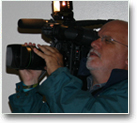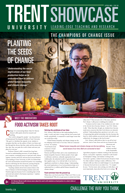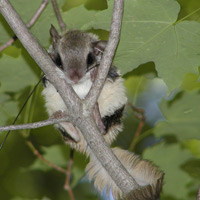
 |
  Groundbreaking Research Reveals First Example of Hybridization Between Species as Result of Climate ChangeFOR IMMEDIATE RELEASE Research Involving Trent Researchers and Graduate Students has Important Implications for BiodiversityTuesday, June 16, 2009, Peterborough
An international collaboration between Canadian and American university and government research agencies, the research study, recently published in the Early View section of the journal Global Change Biology under the title “Climate change induced hybridization in flying squirrels,” examines the behaviour and genetic structure of southern and northern flying squirrels at their range boundary. Recently, following several warm winters, the southern flying squirrel rapidly expanded its range north, increasing overlap with the range of a closely related species, the northern flying squirrel. In the new area of range overlap, the researchers have demonstrated that the two squirrel species began to interbreed. “We are interested in understanding the impacts of climate change on evolutionary processes,” explains Colin Garroway, a Ph.D. candidate in the Environmental & Life Sciences graduate program at Trent who has been working on the project as part of his dissertation. “Climate change threatens biodiversity primarily because organisms are increasingly finding themselves in environments to which they are not adapted. A particularly common response to shifting climate regimes is for population ranges to track shifting climates, resulting in species range expansions and contractions. This pattern of climate change-induced hybridization may be a common result of species range shifts and could act to reduce biodiversity as species and populations merge and selective pressures are altered.” Species can respond to climate change by adapting in place, shifting to newly suitable environments, or going extinct. Research has shown that many animal populations have shifted their geographic ranges in response to contemporary climate change, as was seen in flying squirrels. This will often provide opportunities for hybridization between closely related species. When two species hybridize, the genetic diversity of parental lineages is often reduced, as the species are replaced by genetic hybrids. This can effectively result in a net loss of biodiversity. Hybridization might also sometimes facilitate adaptation to changing environments by quickly introducing new genes and gene combinations upon which natural selection can act. The researchers involved in this ground-breaking project suggest that climate change-induced hybridization may be common, and could act to reduce biodiversity as species and populations merge and selective pressures are altered. “This is the first example of hybridization in response to contemporary climate change, and the first example of hybridization in North American flying squirrels,” says Mr. Garroway. “We hope that our research will stimulate further similar research on other species. In future work we hope to answer more basic questions regarding the maintenance of species boundaries and the biology of species at their range margins.” -30- To view the complete “Climate change induced hybridization in flying squirrels” article in the Global Change Biology journal, visit: http://www3.interscience.wiley.com/cgi-bin/fulltext/122326948/HTMLSTART For more information, please contact: |

































 New collaborative research, led by Trent University and Ontario Ministry of Natural Resources researchers has revealed the first example of hybridization in North American flying squirrels and suggests that hybridization between species may increase as a consequence of contemporary climate change.
New collaborative research, led by Trent University and Ontario Ministry of Natural Resources researchers has revealed the first example of hybridization in North American flying squirrels and suggests that hybridization between species may increase as a consequence of contemporary climate change.